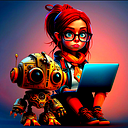Beyond Aesthetics: Decoding the Art & Science of UI/UX Design
(Highlights both creative and technical aspects)
(✔) Introduction
The world of UI/UX design is often mistaken for pure visual artistry. While aesthetics do play a role, there’s a powerful blend of creative thinking and technical expertise that goes into crafting exceptional user experiences. Let’s delve deeper and decode the art and science behind UI/UX design.
Understanding the User: The Art of Empathy
Great UI/UX design starts with a deep understanding of the user. This is where the artistic side comes in:
- User Research: Here, we put on our detective hats ️♀️. We conduct user interviews, observe user behavior, and analyze data to uncover their needs, wants, and pain points. It’s about seeing the world through their eyes and understanding their emotional journey.
- Personas & Storytelling: Based on research, we craft user personas — fictional characters that represent our target audience. These personas help us weave a narrative — the story of how users will interact with the product and achieve their goals.
(⚙️) Building the Interface: The Science of Usability
Once we understand the user, we translate insights into a usable and functional interface. Here’s where the science kicks in:
- Information Architecture: Just like organizing a bookshelf, information architecture involves structuring content in a logical and easy-to-navigate way. Users shouldn’t have to hunt for what they need — it should be readily apparent.
- Interaction Design: This is where the magic of user flow comes in. We design the path users take to complete tasks, ensuring it’s smooth, intuitive, and free of roadblocks. Think of it like designing a clear and efficient route on a map.
- Usability Testing: Science thrives on experimentation, and so does UI/UX design. Usability testing involves observing real users interact with the interface and identifying any areas of confusion or frustration. It’s a scientific approach to refining the design until it feels natural and effortless.
() The Tools of the Trade
While creativity is essential, UI/UX designers also rely on a robust toolbox:
- Design Software: From wireframing tools to prototyping software, designers utilize a variety of programs to visualize their ideas and create interactive prototypes for testing.
- User Research Tools: Surveys, heatmaps, and analytics tools help us gather valuable data about user behavior and preferences.
The UI/UX Designer: A Master of Balance
A successful UI/UX designer is a master of balancing these two worlds:
- Creative Problem-Solving: They approach challenges with a creative mindset, constantly brainstorming innovative solutions to user problems.
- Technical Expertise: They understand design principles, information architecture, and user interaction patterns. This technical knowledge ensures the creativity translates into a functional and usable product.
() Collaboration is Key
UI/UX design is rarely a solo act. Here’s why teamwork is essential for success:
- Cross-Functional Collaboration: Designers work closely with developers, product managers, and content creators to ensure a cohesive experience across all touchpoints. It’s like an orchestra — each member plays a crucial role in creating a beautiful symphony.
- Communication is King: Clear and consistent communication is key. Designers need to effectively articulate their vision to other team members, ensuring everyone is on the same page regarding user experience goals.
The Future of UI/UX
The landscape of UI/UX is constantly evolving. Here’s a peek into what’s ahead:
- Emerging Technologies: From voice interfaces to artificial intelligence, UI/UX designers will need to embrace new technologies to create seamless and engaging experiences across different platforms.
- Focus on Personalization: As user expectations rise, the need for personalized experiences will grow. UI/UX designers will play a key role in crafting interfaces that adapt to individual user needs and preferences.
() Conclusion
UI/UX design is a powerful blend of art and science. By combining creativity with technical expertise, user-centered research, and effective collaboration, we can design experiences that are not only aesthetically pleasing but also functional, intuitive, and ultimately drive business success. So next time you use a product that feels effortless and enjoyable, remember — that’s the art and science of UI/UX design at work!
If you found this article helpful, attractive, useful and would like to support me, make sure to:
— — — — — — — — — — — — — — — — — — — — — — — — — — — — — — — — —
Authored by: [Niamh]
This collaborative research-driven exploration required [1] day of dedication and [2 to 3] hours of meticulous crafting.
Let’s get connected on Twitter: [@niamh_dcreator]
Thank you for your interest.
— — — — — — — — — — — — — — — — — — — — — — — — — — — — — — — — —
